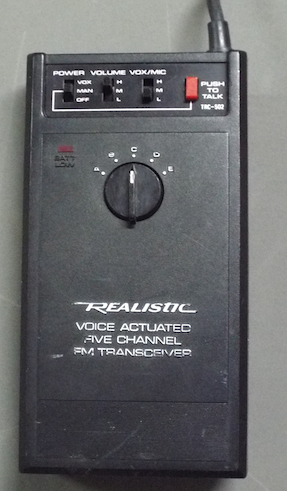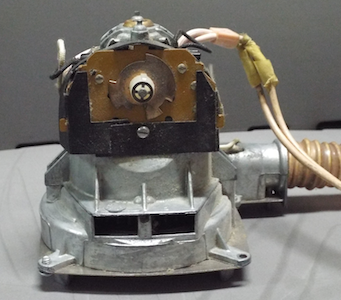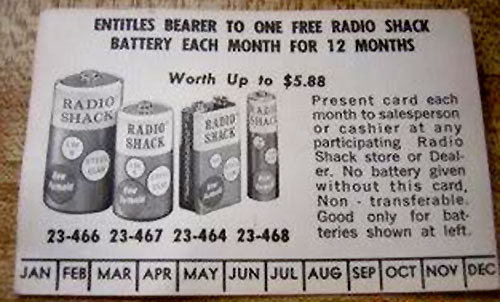When I was 10, I started taking things apart. I disassembled toys, record players, telephones. If I looked at the mechanical parts long enough, they started to speak to me, and I understood them. But the electronics were just mysterious multicolored parts. I couldn’t get them to talk to me. My parents had backgrounds in linguistics and art. They couldn’t teach me electronics, but they helped me in the best way possible. They didn’t take away my screwdriver.
The first time I walked into a Radio Shack store was in the early 1970s. There they were, all the electronic parts that had baffled me, hung on the walls in neat packages. There were soldering irons and do-it-yourself kits for beginners. Best of all there were books, explaining how everything worked. I had found my place.
Soon I was saving all my money for trips to Radio Shack. They had a card that entitled you to one free battery per month. I kept that card in my wallet. Every month a flier would arrive in the mail with my name on it, and I eagerly leafed through it. Books were on sale! I needed more books. Prototype boards? Perfect for the microcomputer I was designing. A voice actuated five channel FM transceiver? I wasn’t sure what that was good for, but I bought three.

Turns out these were good for something. You could put on the headphones and pretend to be out for a stroll, listening to tunes on your Walkman. What you were really listening to was conversations from every cordless phone and baby monitor within two hundred feet. Parents, see how educational electronics can be?
After school I spent hours sitting at a workbench in my room, books open, parts all laid out, building things. I started with educational kits, then moved on to creating my own inventions. Things that just needed to exist, but no sane, bottom-line-focused company would ever mass-produce. A tie clip that counted in binary. A talking alarm clock. A night light you could turn off by whistling. A remote-controlled vacuum cleaner. A confetti cannon. Insulated rubber gloves that would produce a 20,000 volt arc across the fingertips. A frying pan for Play-doh. My parents were just happy I wasn’t doing drugs.
Sometimes the salesmen at Radio Shack tried to fill my appetite for knowledge, but more and more often I found I knew more than they did. In the 80s, Radio Shack stores had some of the very first personal computers, and when no one was looking, I’d type a quick BASIC program into the display model that would put it into an infinite loop. Most of the salesmen didn’t know how to stop it.
But in the 90s, Radio Shack changed. One day I walked into a store and all my beloved parts were gone from the walls. In their place were consumer electronics; cordless phones, CD players, and high-end TVs. When I finally got a salesman to pay attention to me, and asked where I could find the parts, I was shown a pitiful rack of drawers tucked in the back of the store. I went home and removed the Radio Shack battery card from my wallet.
By the time I had gotten my first job as an electrical engineer, I’d found other sources for electronic parts. First through mail order catalogs and later the internet. I occasionally went back to Radio Shack when I needed to pick up something right away, but it was no longer my place. My Radio Shack had died.
Over the years I watched from a distance as the new Radio Shack floundered against bigger consumer electronics stores like Best Buy and Circuit City. Electronics became harder for the consumer to repair themselves. Sometimes you couldn’t even open them with a screwdriver. I didn’t think there was any way the old Radio Shack could ever come back.
But then came the new age of tinkering. Elementary schools started teaching classes in robotics. Cheap microcontrollers allowed today’s kids to build things I’d only dreamed of. A full-blown computer on a tiny board now cost $35. 3D printers became inexpensive enough for home use. Could Radio Shack grab onto this new wave? I’d heard rumors that Radio Shack planned on reinventing itself, and they were going to run an ad during the 2014 Super Bowl. Would they welcome the experimenter back? Could Radio Shack be my place again?
Then I saw the ad. This one:
Radio Shack didn’t want the experimenter, playing with technology, they wanted the 30-year-old, looking for a pre-packaged product. Worse yet, Radio Shack was trying to do it using pop icons from the 80s that their 30-year-old would not even remember. I knew then that my Radio Shack would never return from the grave.
On Feb 5, 2015, Radio Shack filed for bankruptcy. Goodbye, old friend, I’ll miss you. But I did all my mourning years ago.

60/40 rosin-core solder. Nobody makes this any more because of concerns about lead poisoning, but I still have a few rolls, and I still have my soldering iron. When you touch the solder to the tip of the hot iron, the rosin flux vaporizes and a little wisp of smoke curls past your face. If I close my eyes and breathe in, I’m a teenager again, sitting at my work bench, parts spread in front of me, books open. This is my place.







